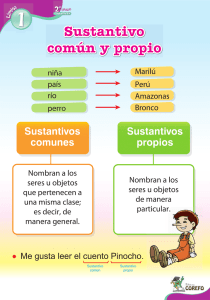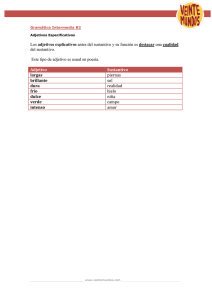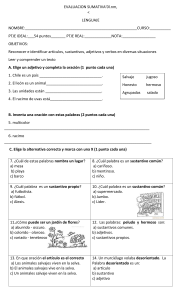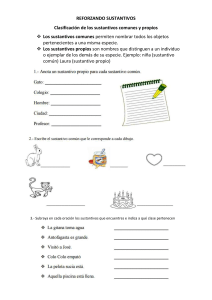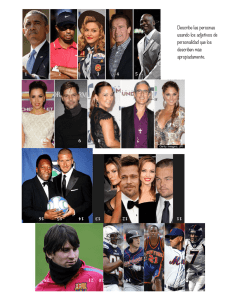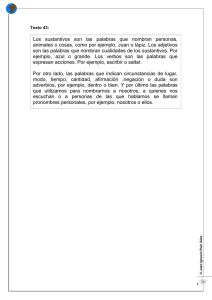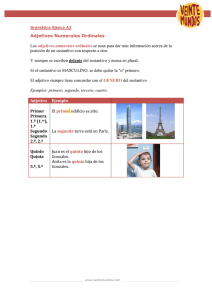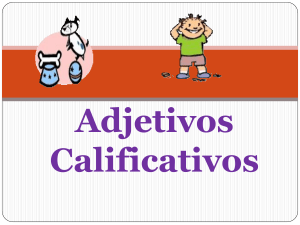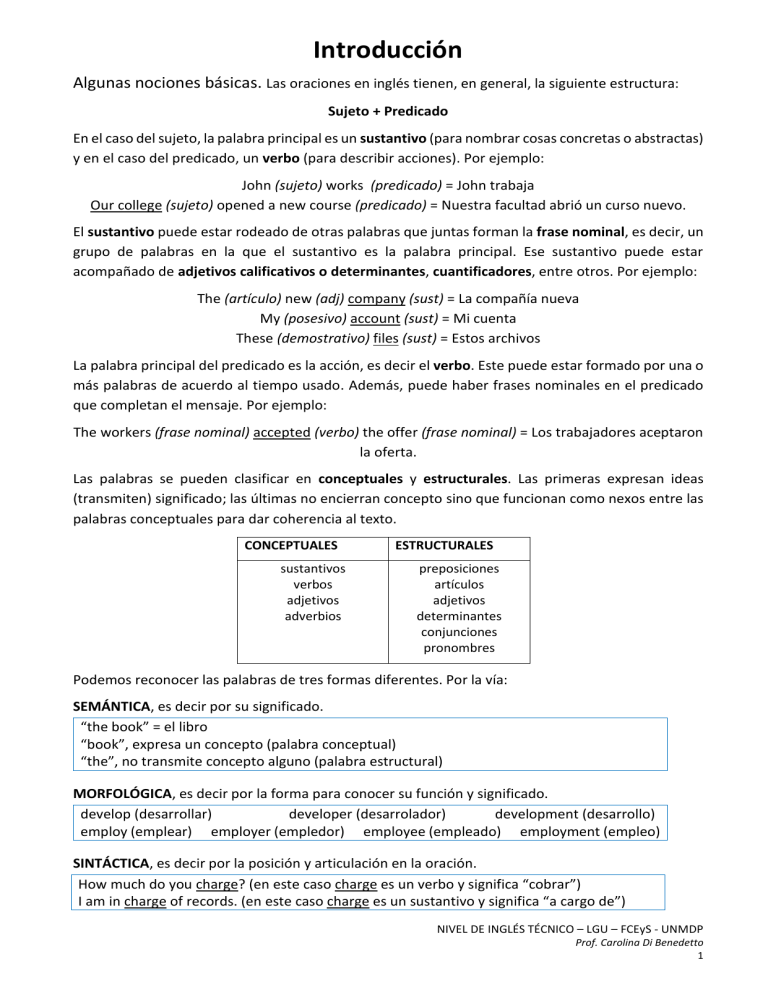
Introducción Algunas nociones básicas. Las oraciones en inglés tienen, en general, la siguiente estructura: Sujeto + Predicado En el caso del sujeto, la palabra principal es un sustantivo (para nombrar cosas concretas o abstractas) y en el caso del predicado, un verbo (para describir acciones). Por ejemplo: John (sujeto) works (predicado) = John trabaja Our college (sujeto) opened a new course (predicado) = Nuestra facultad abrió un curso nuevo. El sustantivo puede estar rodeado de otras palabras que juntas forman la frase nominal, es decir, un grupo de palabras en la que el sustantivo es la palabra principal. Ese sustantivo puede estar acompañado de adjetivos calificativos o determinantes, cuantificadores, entre otros. Por ejemplo: The (artículo) new (adj) company (sust) = La compañía nueva My (posesivo) account (sust) = Mi cuenta These (demostrativo) files (sust) = Estos archivos La palabra principal del predicado es la acción, es decir el verbo. Este puede estar formado por una o más palabras de acuerdo al tiempo usado. Además, puede haber frases nominales en el predicado que completan el mensaje. Por ejemplo: The workers (frase nominal) accepted (verbo) the offer (frase nominal) = Los trabajadores aceptaron la oferta. Las palabras se pueden clasificar en conceptuales y estructurales. Las primeras expresan ideas (transmiten) significado; las últimas no encierran concepto sino que funcionan como nexos entre las palabras conceptuales para dar coherencia al texto. CONCEPTUALES sustantivos verbos adjetivos adverbios ESTRUCTURALES preposiciones artículos adjetivos determinantes conjunciones pronombres Podemos reconocer las palabras de tres formas diferentes. Por la vía: SEMÁNTICA, es decir por su significado. “the book” = el libro “book”, expresa un concepto (palabra conceptual) “the”, no transmite concepto alguno (palabra estructural) MORFOLÓGICA, es decir por la forma para conocer su función y significado. develop (desarrollar) developer (desarrolador) development (desarrollo) employ (emplear) employer (empledor) employee (empleado) employment (empleo) SINTÁCTICA, es decir por la posición y articulación en la oración. How much do you charge? (en este caso charge es un verbo y significa “cobrar”) I am in charge of records. (en este caso charge es un sustantivo y significa “a cargo de”) NIVEL DE INGLÉS TÉCNICO – LGU – FCEyS - UNMDP Prof. Carolina Di Benedetto 1 EL SUSTANTIVO Según su forma los sustantivos pueden ser simples, derivados o compuestos. SIMPLES - Generalmente son monosilábicos y de origen netamente sajón, por ejemplo: law (ley) thing (cosa) box (caja) DERIVADOS - Constituyen el grupo más numeroso de sustantivos del idioma inglés. La palabra base cambia de función de acuerdo al sufijo con que termina: develop (verbo) desarrollar market (sustantivo) mercado development (sustantivo) desarrollo marketer (sustantivo) hacedores de mercado Otros sufijos (ver Anexo 1) usados para formar sustantivos son: ance ence or er ist ness hood ing inheritance difference actor writer typist darkness neighbourhood meeting COMPUESTOS a) Escritos como una sola palabra: spokesman (spoke : proveniente del verbo hablar; man : hombre) = portavoz b) Unidos por un guión: father-in-law = suegro c) Como dos palabras separadas: waiting list = lista de espera post office = oficina de correo ACCIDENTES DEL SUSTANTIVO El sustantivo es la única palabra conceptual que tiene género (masculino, femenino) y número (singular, plural). Los siguientes son algunos ejemplos de género y número. GENERO father actor mother actress boy man girl woman NUMERO Muchos sustantivos que agregan la letra “s” para formar su plural: screen (pantalla) step (paso) resource (recurso) sample (muestra) student estudiante) sheet (hoja) cost (costo) NIVEL DE INGLÉS TÉCNICO – LGU – FCEyS - UNMDP Prof. Carolina Di Benedetto 2 Hay una cantidad de sustantivos que forman el plural de otras maneras. Ellos son: I) Los sustantivos que terminan en “s”, “z”, “x”, “ch”, o “sh” en su forma singular, agregan “es” en su forma plural. loss (pérdida) class (clase) buzz (zumbido) box (caja) switch (interruptor) bench (banco) flash (destello) dish (plato) IV) Los sustantivos que terminan en su forma singular en la letra “o” precedida por consonante, agregan la terminación “es”. hero (héroe) potato (papa) Sin embargo, las palabras que terminan en “o” que tienen origen en los idiomas español o italiano, sólo agregan la letra “s”. radio (radio) photo (foto) V) Hay otro grupo de sustantivos, muy antiguos y II) Los sustantivos que terminan en “y” de uso cotidiano, que presentan formas precedida por una consonante, cambian la “y” especiales para expresar el plural. final por “i” y luego agregan la partícula “es”. man (hombre) strategy (estrategias) woman (mujer) memory (memoria) foot (pie) laboratory (laboratorio) tooth (diente) property (propiedad) child (niño) Sin embargo, los sustantivos que terminan en “y” precedida por una vocal, simplemente agregan la letra “s”. key (tecla, llave, clave) pay (pago) way (forma, camino) VI) Los sustantivos con origen en el latín o el griego, forman el plural como lo hacían en los idiomas de origen, y en general son términos relacionados a las ciencias. medium (medio) datum (dato) axis (eje) III) La mayoría de los sustantivos que terminan en las letras “f” o “fe” cambian estas basis (base) terminaciones por la partícula “ves”. nucleus (núcleo) half (mitad) fungus (hongo) leaf (hoja) phenomenon (fenómeno) knife (cuchillo) criterion (criterio) life (vida) maximum (máximo) minimum (mínimo) Existen algunas excepciones a esta regla. proof (prueba) chief (jefe) belief (creencia) EL ARTÍCULO El sustantivo puede ir acompañado de los artículos indefinido, a o an, (un o una) o definido, the (el, la, los, las) a student a house an hour a year the student the students the screen the screens NIVEL DE INGLÉS TÉCNICO – LGU – FCEyS - UNMDP Prof. Carolina Di Benedetto 3 EJERCICIO Nº 1 Escriba los significados y las formas plurales de los siguientes sustantivos. 1. window 16. medium 2. glass 17. sheet 3. axis 18. echo 4. woman 19. file 5. theory 20. law 6. datum 21. foot 7. knife 22. box 8. number 23. dish 9. way 24. phase 10. process 25. benefit 11. resource 26. exercise 12. time 27. interview 13. opportunity 28. appointment 14. application 29. offer 15. criterion 30. enquiry EJERCICIO Nº 2 Escribir “a” o “an”, luego traducir EJERCICIO Nº 3 Traducir 1. ……. tutor 1. the development 2. ……. resource 2. a tutor 3. ……. development 3. the resources 4. ……. strategy 4. the academics 5. ……. discipline 5. the facilities 6. ……. environment 6. an environment 7. ……. area 7. the thought 8. ……. hour 8. a school 9. ……. wall 9. the colleges 10. ……. student 10. the strategies 11. ……. analyst 11. the system 12. ……. lecturer 12. the data NIVEL DE INGLÉS TÉCNICO – LGU – FCEyS - UNMDP Prof. Carolina Di Benedetto 4 Working pattern Full time almost 15,500 undergraduate and over 4,500 postgraduate students administrative support these students and the academic processes exceptional administrators the communication, drive and customer care skills a high quality service the Selection Process exciting opportunities an open ended and fixed term basis a centralised recruitment process an initial first stage review the selection criteria your previous experiences initial criteria your computer literacy situational judgement exercises to a selection and assessment interview a final interview the relevant academic School a potential job offer. informal enquiries excellent remuneration and other benefits generous annual leave entitlement staff discounts generous pension scheme training and development opportunities an inclusive and supportive working environment fully inclusive culture. freelance tutor human resources NIVEL DE INGLÉS TÉCNICO – LGU – FCEyS - UNMDP Prof. Carolina Di Benedetto 5 Skills Development Coach, Management/Project Management Assistant Professor/Associate Professor/Professor, Human Resources Management Freelance Digital Technology Project Supervisor Junior Business Systems Analyst Senior Lecturer / Lecturer in Leadership & Management LECTURERS an ambitious, quality-driven strategy a world-class business school in research, education and Enterprise a number of new, outstanding academics Business School in various disciplines. have an outstanding reputation for research, education and enterprise. Statistics and Operational Research a highly stimulating, challenging and dynamic environment. a relevant area teaching experience high-quality research publications. a research project team. our lively Highfield campus state-of-the-art teaching and research facilities our sports complex a £300m bond investment the University’s future and long-term stability. some fantastic benefits 44 days leave per year excellent family leave arrangements (including maternity, paternity, adoption, parental and carers’ leave) a wide variety of on and off-campus arts and cultural facilities; and access to a range of staff discounts and offers at local shops, restaurants and service providers. inclusive working environment retaining a diverse range of staff from many different backgrounds independent thought. University business schools are centres for business education and research. Academic jobs are available in specialist areas such as accounting, law and taxation, enterprise, business engagement and innovation, human resources, operations and strategy, marketing, organisational behaviour and international relations. El adjetivo El adjetivo es una palabra conceptual que actúa como modificador del sustantivo en la oración. Es decir, brinda información sobre los sustantivos. Los adjetivos se clasifican en: a) determinantes (palabras estructurales) NIVEL DE INGLÉS TÉCNICO – LGU – FCEyS - UNMDP Prof. Carolina Di Benedetto 6 b) calificativos (palabras conceptuales) a) Adjetivos determinantes (ver Anexo 1) Los adjetivos determinantes a su vez se dividen en: Demostrativos this, that, these, those Distributivos each, every, either, neither Cuantitativos some, any, no, little, few… Interrogativos which, what, whose Posesivos my, your, his, her, its, our, your, their No change was detected. No se detectó ningún cambio. In some countries, students pay for their education. En algunos países los estudiantes pagan por su educación. Which course are you doing? ¿Cuál curso estás haciendo? b) Adjetivos calificativos o modificadores Los adjetivos le confieren una cualidad al sustantivo que acompañan. Casi siempre se encuentran antes del sustantivo y no tienen ni género ni número. Al traducirlos seguimos el género y número del sustantivo al cual modifican. It is a famous theory. Es una teoría famosa. These economists are very famous. Estos economistas son muy famosos Los de adjetivos pueden ser, según su forma, simples, derivados o compuestos. 1- Simples: no poseen prefijos ni sufijos y se los reconoce por su posición en la oración. Ejemplos: new, large, old, easy 2- Derivados: Se forman a partir de otras palabras, verbos o sustantivos, con el agregado de sufijos. (ver Anexo 4). Ejemplos: power religion analyse powerful religious analysed Otros sufijos que forman adjetivos: -able, íble, -less, -ic, -ical, -ish, -ive, -ful, -al 3- Compuestos: Se forman de maneras variadas y a veces se deben traducir mediante un grupo de palabras. general purpose device dispositivo para usos múltiples NIVEL DE INGLÉS TÉCNICO – LGU – FCEyS - UNMDP Prof. Carolina Di Benedetto 7 worlwide organization lifelong education organización mundial educación de toda la vida/a lo largo de toda la vida ESTUDIO SINTÁCTICO En la mayoría de los casos, el adjetivo es un pre modificador, es decir que aparece previo al sustantivo al que modifica. Ejemplos: large company efficient program annual revenue gran compañía o compañía grande programa eficiente ganancia annual En castellano, tendemos a usar primero es sustantivo y luego el adjetivo, aunque en algunas ocasiones también es posible usarlo como pre modificador. COMPARACION DE ADJETIVOS 1- Adjetivos de una sílaba y algunos de dos: GRADO POSITIVO GRADO COMPARATIVO GRADO SUPERLATIVO dark useful darker more useful darkest most useful Estos adjetivos cortos forman su comparativo y superlativo agregando las terminaciones –er y respectivamente al grado positivo. Ejemplos: -est XX is a big chain of restaurants. Pizza Hut es una gran cadena de restaurantes. Fish and Chips is bigger than Pizza Hut. Fish and Chips es más grande que Pizza Hut. McDonald´s is the biggest chain of fast-food restaurants. McDonald´s es la cadena más grande de restaurantes de comidas rápidas. NIVEL DE INGLÉS TÉCNICO – LGU – FCEyS - UNMDP Prof. Carolina Di Benedetto 8 2- Adjetivos de dos o más sílabas Estos forman su comparativo y superlativo anteponiendo los adverbios “more” y “most”. GRADO POSITIVO expensive powerful GRADO COMPARATIVO more expensive more powerful GRADO SUPERLATIVO most expensive most powerful The SmartCar is more powerful than the Chevrolet´s Corsa. El SmartCar es más poderoso que el Corsa de Chevrolet. This marketing campaign has been the most expensive is many years. Esta campaña de marketing ha sido la más cara en muchos años. 3- Algunos casos especiales de construcción de comparativos: - AS + ADJETIVO + AS NOT AS + ADJETIVO + AS Line B is as long as line A. La línea B es tan larga como la línea A. A B Line C is not as long as line B. La línea C no es tan larga como la línea B. - C B Para expresar proporcionalidades, se suele usar esta estructura: THE + comparativo. THE + comparativo The greater the gap, the greater the frustration. A mayor diferencia, mayor frustración. The longer the contact, the more complete is the experience. Mientras mayor es el contacto, más completa es la experiencia 4- Cambios ortográficos Algunos adjetivos sufren cambios ortográficos al tomar las terminaciones de comparativo y superlativo, que es importante tener en cuenta a los efectos de la búsqueda en el diccionario. Adjetivos terminados en “y” precedida de consonante cambian “y” por “i”. easy big easier easiest Cuando terminan en consonante precedida de vocal duplican la consonante. bigger biggest Cuando terminan en “e” solo se agregan “r” o “st” NIVEL DE INGLÉS TÉCNICO – LGU – FCEyS - UNMDP Prof. Carolina Di Benedetto 9 wide wider widest LECTURERS Southampton Business School has an ambitious, qualitydriven strategy, which will see us strengthen our position as a world-class business school in research, education and enterprise. We are currently looking for a number of new, outstanding academics to join us as Lecturers within our expanding Business School in various disciplines. Part of a world-renowned, Top-100 QS-ranked, Russell Group University, we have an outstanding reputation for research, education and enterprise. The Business School has recently secured AACSB accreditation, in addition to AMBA for our MBA. We are also aiming for EQUIS accreditation within the next 18 months. This year (2019) our CORMSIS research centre has been ranked within the QS world Top 50 for Statistics and Operational Research and 7th in the UK. If you’re interested in a role at 0.6FTE or above, you could play a crucial role in helping us to achieve our vision. What’s more, you will be working within a highly stimulating, challenging and dynamic environment. ABOUT YOU You will hold a PhD in a relevant area (or equivalent qualifications/experience), will have teaching experience and be able to provide evidence that you can produce high-quality research publications. Ideally, you will also have experience of working in a research project team. WHAT WE CAN OFFER YOU Based at our lively Highfield campus, you will have access to state-of-the-art teaching and research facilities, as well as our sports complex, Hartley Library and Staff Social Centre. Having secured a £300m bond investment, we are committed to investing in the University’s future and long-term stability. We offer some fantastic benefits including: 44 days leave per year; options for flexible working; excellent family leave arrangements (including maternity, paternity, adoption, parental and carers’ leave); a wide variety of on and off-campus arts and cultural facilities; and access to a range of staff discounts and offers at local shops, restaurants and service providers. The UoS is committed to supporting and promoting equality and diversity to create an inclusive working environment. We believe this can be achieved through attracting, developing, and retaining a diverse range of staff from many different backgrounds who share our ambition to be a university recognised for delivering world-class research and creating a community that values independent thought. Division/School Multiple Schools Contract type Open ended contract staff Working pattern Full time Salary £23,334 - £26,243 per annum Closing date for applications 14-Apr-2019 The University of Bristol has almost 15,500 undergraduate and over 4,500 postgraduate students. Providing administrative support to these students and the academic processes within the individual Schools across the University can be highly challenging but also highly rewarding. The University is seeking exceptional administrators to be part of its Faculty Student Administration function providing this support. The Role NIVEL DE INGLÉS TÉCNICO – LGU – FCEyS - UNMDP Prof. Carolina Di Benedetto 10 The role of a Faculty Student Administrator (FSTA) is wide ranging. Successful candidates will be able to demonstrate a number of competencies including attention to detail, flexibility in approach to work and the ability to manage often conflicting deadlines. The ability to work under your own initiative and with a high degree of self-motivation is also required. Ideally you will already have some relevant experience and possess the communication, drive and customer care skills to deliver a high quality service to a range of stakeholders at all levels. Experience of working with a range of IT systems and software, in particular MS Excel, is also strongly preferred. The Selection Process Applications are now open for these exciting opportunities. The University is interested in receiving applications for these roles on both an open ended and fixed term basis and will be using a centralised recruitment process to progress applications. Once we have received your application, we will conduct an initial first stage review of how well your application demonstrates that you meet the selection criteria so it is important that you tailor your application to meet these requirements using examples from your previous experiences. If you meet our initial criteria, you will be asked to complete a set of tests online which will assess your computer literacy along with situational judgement exercises that aim to replicate the type of activities you will face in the role. If you are successful at stage one and two, you will then be invited to a selection and assessment interview here at the University. Candidates who are successful at this stage of the process will then be invited to attend a final interview to meet the recruiting managers from the relevant academic School. Success at this final stage will lead to an offer of employment from the recruiting school. It will usually take around six to eight weeks to get from your initial application to a potential job offer. For informal enquiries please contact: studentadmin-recruitment@bristol.ac.uk The University offers excellent remuneration and other benefits including generous annual leave entitlement, staff discounts, generous pension scheme, training and development opportunities as well as an inclusive and supportive working environment. For more information on these and other staff benefits please visit our website - www.bristol.ac.uk/jobs/staff-benefits/ We reserve the right to remove the advert if candidate numbers are sufficient for our needs. The University is committed to creating and sustaining a fully inclusive culture. We welcome applicants from all backgrounds and communities. NIVEL DE INGLÉS TÉCNICO – LGU – FCEyS - UNMDP Prof. Carolina Di Benedetto 11
